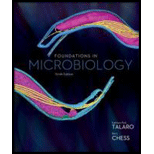
Concept explainers
What do you suppose the world would be like if there were cures for all infectious diseases and a means to destroy all microbes? What characteristics of microbes would prevent this from happening?
To analyze:
- The scenario if cures for all infectious diseases were found and all microbes could be destroyed.
- The characteristics of microbes that would prevent such a situation from happening.
Introduction:
Infectious diseases caused by micro-organisms are a cause of widespread mortality and morbidity. While some infectious diseases have been eradicated because of vaccination and antibiotics, many others still continue to prevail. Currently, almost 2000 different pathogens infect humans and cause diseases, and more than 10 billion infections are reported across the globe, each year. This is because antibiotics are ineffective against many micro-organisms. Such micro-organisms have devised strategies to counteract the effect of antibiotics, and are causing infections in humans.
Explanation of Solution
If we imagine a scenario where cures for all infectious diseases have been found, there would be a significant increase in the lifespan of humans. Consequently, humans will over-populate the earth and cause a tremendous pressure on natural resources. If all microbes would be destroyed, there would be drastic changes in ecosystems and natural processes. The oxygen content in the atmosphere would reduce to critical levels, because of absence of photosynthesizing bacteria. Decomposition and mineral recycling will cease, thereby making elements inaccessible to humans and plants. The levels of greenhouse gases like carbon dioxide and methane would go down, and this would make the temperature of the earth fall down severely. All these changes would in turn make earth inhabitable for humans, and threaten their existence.
The immense resistance of micro-organisms gives them the ability to thrive under extremes of temperature, salt content and pH, and in toxic wastelands, radioactive areas and even in volcanoes. They are able to adapt quickly and become drug-resistant, thereby making it difficult for us to destroy them.
Want to see more full solutions like this?
Chapter 1 Solutions
Foundations in Microbiology
- Ch.22 Streptococcus pneumoniae has a capsule to protect it from killing by alveolar macrophages, which kill bacteria by… A. cytokines B. antibodies C. complement D. phagocytosis — What fact about the influenza virus allows the dramatic antigenic shift that generates novel strains? A. very large size B. enveloped C. segmented genome D. over 100 genes — explain your answer thoroughlyarrow_forwardWhat is this?arrow_forwardMolecular Biology A-C components of the question are corresponding to attached image labeled 1. D component of the question is corresponding to attached image labeled 2. For a eukaryotic mRNA, the sequences is as follows where AUGrepresents the start codon, the yellow is the Kozak sequence and (XXX) just represents any codonfor an amino acid (no stop codons here). G-cap and polyA tail are not shown A. How long is the peptide produced?B. What is the function (a sentence) of the UAA highlighted in blue?C. If the sequence highlighted in blue were changed from UAA to UAG, how would that affecttranslation? D. (1) The sequence highlighted in yellow above is moved to a new position indicated below. Howwould that affect translation? (2) How long would be the protein produced from this new mRNA? Thank youarrow_forward
- Molecular Biology Question Explain why the cell doesn’t need 61 tRNAs (one for each codon). Please help. Thank youarrow_forwardMolecular Biology You discover a disease causing mutation (indicated by the arrow) that alters splicing of its mRNA. This mutation (a base substitution in the splicing sequence) eliminates a 3’ splice site resulting in the inclusion of the second intron (I2) in the final mRNA. We are going to pretend that this intron is short having only 15 nucleotides (most introns are much longer so this is just to make things simple) with the following sequence shown below in bold. The ( ) indicate the reading frames in the exons; the included intron 2 sequences are in bold. A. Would you expected this change to be harmful? ExplainB. If you were to do gene therapy to fix this problem, briefly explain what type of gene therapy youwould use to correct this. Please help. Thank youarrow_forwardMolecular Biology Question Please help. Thank you Explain what is meant by the term “defective virus.” Explain how a defective virus is able to replicate.arrow_forward
- Molecular Biology Explain why changing the codon GGG to GGA should not be harmful. Please help . Thank youarrow_forwardStage Percent Time in Hours Interphase .60 14.4 Prophase .20 4.8 Metaphase .10 2.4 Anaphase .06 1.44 Telophase .03 .72 Cytukinesis .01 .24 Can you summarize the results in the chart and explain which phases are faster and why the slower ones are slow?arrow_forwardCan you circle a cell in the different stages of mitosis? 1.prophase 2.metaphase 3.anaphase 4.telophase 5.cytokinesisarrow_forward
- Which microbe does not live part of its lifecycle outside humans? A. Toxoplasma gondii B. Cytomegalovirus C. Francisella tularensis D. Plasmodium falciparum explain your answer thoroughly.arrow_forwardSelect all of the following that the ablation (knockout) or ectopoic expression (gain of function) of Hox can contribute to. Another set of wings in the fruit fly, duplication of fingernails, ectopic ears in mice, excess feathers in duck/quail chimeras, and homeosis of segment 2 to jaw in Hox2a mutantsarrow_forwardSelect all of the following that changes in the MC1R gene can lead to: Changes in spots/stripes in lizards, changes in coat coloration in mice, ectopic ear formation in Siberian hamsters, and red hair in humansarrow_forward
 Biology Today and Tomorrow without Physiology (Mi...BiologyISBN:9781305117396Author:Cecie Starr, Christine Evers, Lisa StarrPublisher:Cengage Learning
Biology Today and Tomorrow without Physiology (Mi...BiologyISBN:9781305117396Author:Cecie Starr, Christine Evers, Lisa StarrPublisher:Cengage Learning
 Concepts of BiologyBiologyISBN:9781938168116Author:Samantha Fowler, Rebecca Roush, James WisePublisher:OpenStax College
Concepts of BiologyBiologyISBN:9781938168116Author:Samantha Fowler, Rebecca Roush, James WisePublisher:OpenStax College- Basic Clinical Lab Competencies for Respiratory C...NursingISBN:9781285244662Author:WhitePublisher:Cengage





